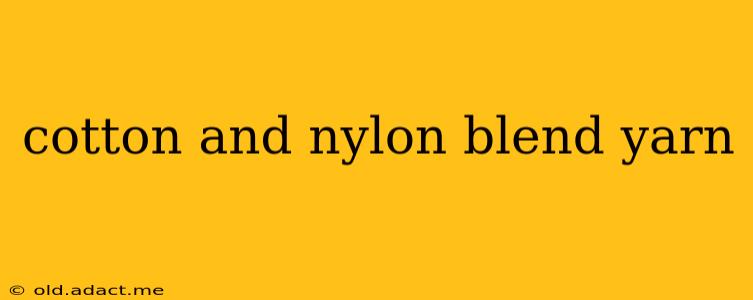Cotton and nylon blend yarn offers a compelling combination of natural comfort and synthetic durability, making it a popular choice for a wide range of textile applications. This guide delves into the properties, benefits, uses, and care instructions for this versatile yarn.
What are the benefits of using a cotton and nylon blend yarn?
The primary advantage of blending cotton and nylon lies in the synergistic properties of each fiber. Cotton provides softness, breathability, and absorbency, while nylon contributes strength, elasticity, and resistance to wrinkles and shrinking. This results in a yarn that's both comfortable and durable, outperforming either fiber alone. The specific benefits vary depending on the blend ratio, but generally include:
- Increased Durability: Nylon's strength significantly enhances the yarn's resistance to wear and tear, extending the lifespan of garments and other textiles.
- Enhanced Elasticity and Shape Retention: Nylon's elastic properties help the fabric retain its shape, reducing wrinkles and sagging.
- Improved Shrink Resistance: Nylon helps prevent shrinkage, ensuring consistent sizing even after washing.
- Better Wrinkle Resistance: The nylon component minimizes wrinkling, making the fabric easier to care for.
- Increased Water Resistance: Though not waterproof, the nylon component offers some level of water resistance compared to pure cotton.
What are cotton and nylon blend yarns used for?
The versatility of cotton and nylon blend yarn makes it suitable for numerous applications, including:
- Apparel: This blend is commonly used in socks, underwear, t-shirts, and other garments where comfort and durability are crucial. The blend ratio often dictates the final product; a higher cotton content might be preferred for softer t-shirts, while a higher nylon content could be better suited for durable socks.
- Home Furnishings: Cotton and nylon blends find their way into upholstery fabrics, curtains, and blankets, offering a balance of softness and resilience.
- Industrial Fabrics: Their strength makes them suitable for applications such as canvas, webbing, and other heavy-duty textiles.
- Knitting and Crochet: Many crafters appreciate this yarn blend for its ease of use and the resulting durability of finished projects.
How do I care for cotton and nylon blend yarn?
Care instructions will vary slightly depending on the specific blend ratio and the manufacturer's recommendations, but generally, cotton and nylon blends are relatively easy to care for. Always check the care label on the garment or yarn before washing. However, some general guidelines include:
- Machine Washing: Most cotton and nylon blends can be machine washed in cold or lukewarm water.
- Gentle Cycle: Opt for a gentle cycle to avoid damaging the fibers.
- Mild Detergent: Use a mild detergent to prevent build-up and preserve the fabric's softness.
- Air Drying: Air drying is generally recommended to prevent shrinking and maintain the fabric's shape. If machine drying is necessary, use a low heat setting.
- Avoid Bleach: Bleach can damage both cotton and nylon fibers, so it's best avoided.
What is the difference between cotton and nylon blend yarn and 100% cotton yarn?
The key difference lies in the properties conferred by the nylon component. While 100% cotton yarn is soft, breathable, and absorbent, it's less durable and more prone to wrinkling and shrinking. A cotton and nylon blend inherits the softness and breathability of cotton but gains significant improvements in durability, elasticity, wrinkle resistance, and shrink resistance thanks to the addition of nylon.
What is the difference between cotton and nylon blend yarn and 100% nylon yarn?
100% nylon yarn is strong, elastic, and water-resistant, but it can lack the softness and breathability of cotton. A cotton and nylon blend balances these properties. The cotton adds comfort and absorbency, making the fabric more comfortable against the skin, while the nylon retains the strength and durability.
Is cotton and nylon blend yarn sustainable?
The sustainability of cotton and nylon blend yarn depends on several factors, including the sourcing of the cotton (organic cotton is more sustainable) and the type of nylon used (recycled nylon is more environmentally friendly). While nylon is a synthetic fiber derived from petroleum, advancements are being made in producing more sustainable nylon alternatives. The overall sustainability should be considered on a case-by-case basis, examining the sourcing and manufacturing processes of the specific yarn.
This comprehensive guide provides a detailed overview of cotton and nylon blend yarn. Understanding its properties, uses, and care requirements will help you make informed decisions when choosing this versatile and durable textile. Remember to always check the care label for specific instructions.
